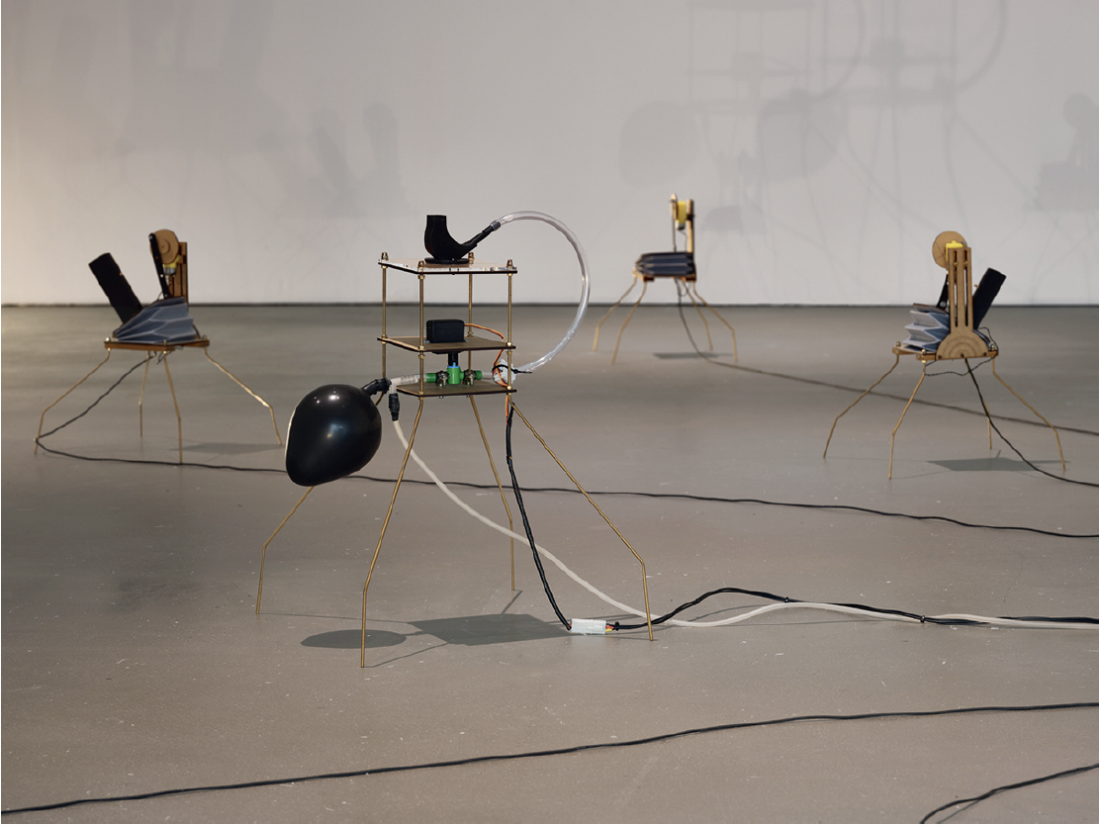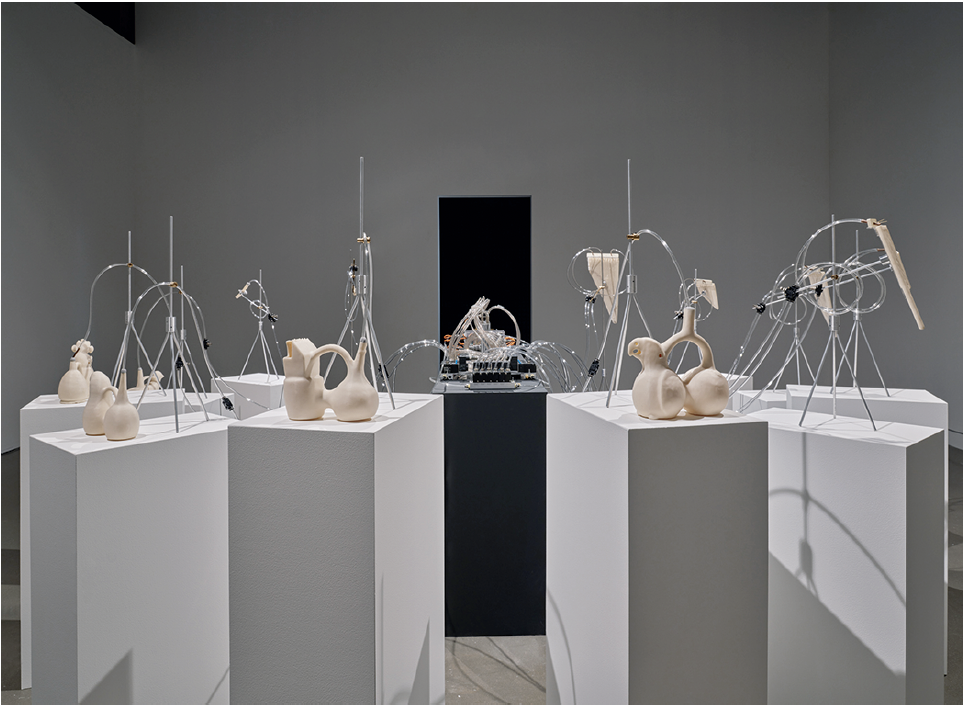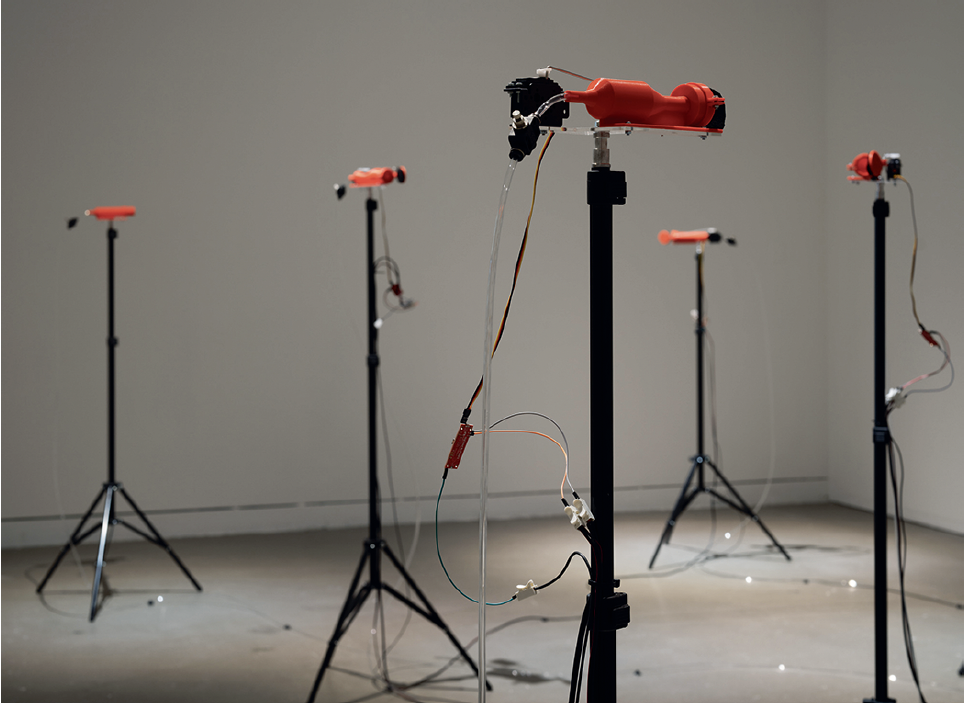“PneumoMachinic”
The exhibition titled “PneumoMachinic” draws its conceptual framework from the etymology of its name. “Pneumo,” derived from the Greek word for “air” or “breath,” and “Machinic,” from the Latin machina, meaning “machine” or “device,” encapsulates the conceptual essence of this show. This sound art exhibition consists of three distinct installations, each occupying a separate gallery room. The overall ambience mirrors that of an underground live music venue where all the “instruments” are wind-based, and the performances are generated by mechanicals and algorithms rather than by human musicians.
In the first gallery, Turkish artist Ali Miharbi’s installation, Whispering I, introduces visitors to a serene auditory experience created by 10 3D-printed red resonators. These resonators, perched atop tripods of varying heights, are meticulously designed to mimic simplified models of the human vocal tract. Connected to an air compressor, these devices emit sounds reminiscent of human whispers and breaths, creating an intimate, almost eerie environment. Visitors standing within this room are enveloped in a continuous auditory landscape of random sigh-like sounds. The resonators, positioned at a height comparable to an adult human’s vocal tract, enhance this effect, making the whispers more audibly accessible. This deliberate positioning transforms the resonators into anthropomorphic forms, inviting viewers to engage more deeply with the installation.

Xoán-Xil, Organismo, 2020, electronic media/ sound installation, dimensions variable. Photo: Rachel Topham Photography. Courtesy New Media Gallery, New Westminster. Additional artists: Supercollider y OpenMusic and Adam Stag y Jerome Turmei.
Typically, whispering is understood as a discreet, private mode of communication. However, Whispering I subverts this notion by rendering the whispers public and apparent, allowing visitors to experience the act of whispering as a shared, almost voyeuristic event. Even though only 10 resonators emit their soft intermittent sounds, the room is permeated with a tension that disrupts the silence, filled with familiar yet unrecognizable auditory fragments. Originally developed by Miharbi in 2016, the “Whispering” series explores the “materiality of sound, information, and its relationship with space.” Through Whispering I, Miharbi invites the audience to reflect on the nature of human speech and language, suggesting that even our most private communications can be made public in the digital age. The use of preprogrammed algorithms to control the random whispering of the resonators further provokes thoughts on the evolving nature of communication in a technologically driven society.
The second gallery features Spanish artist Xoán-Xil’s installation, Organismo (Organscape), an interactive piece that immerses visitors in a mechanical rainforest. Upon entering the room, visitors are greeted by sounds of thunder, birds and wind, creating the illusion of standing in a tropical rainforest. Although the installation features only nine relatively small robotic devices, equipped with resonators and motion sensors, the sound and resonance they produce fill every corner of the exhibition space. Organismo draws from recent research findings on historical instruments, specifically Baroque pipe organs, that replicated environmental sounds of tropical forests. Researchers argue that this sonic mimicry served as a spiritual weapon to facilitate the spread of Christianity among Indigenous populations in Mexico during the colonial era.

Cristhian Ávila Cipriani, El eterno retorno, 2021–2024, electronic media/sound installation, dimensions variable. Photo: Rachel Topham Photography. Courtesy New Media Gallery, New Westminster. Additional artists: Irradia Espacio Público Museo de Arte de Lima MALI, Fundación Telefónica del Perú Carla Ávila, Ysabel Cipriani, Esteban Coronel, Bregy Malpartida, and Hayashi Mateo.
In addition to the auditory experience, this cyberpunk organ is brought to life through the rhythmic up-and-down movement of bellows and pulleys of the robotics, which are activated by motion sensors. As well, exaggerated shadows on the walls cast by deliberate lighting together create an illusion of a group of living entities that move, breathe and produce sound. This immersive experience invites viewers to reconsider the power of sound and the myths surrounding music, prompting reflections on their historical and universal significance.
The third gallery showcases Peruvian artist Cristhian Ávila Cipriani’s installation, El eterno retorno, which offers a unique symphony played by 12 replicas of pre-Hispanic wind instruments from Peru. These 3D-printed replicas, crafted from ceramic-like materials, are connected to an air compressor. Unlike the other installations, the frequency and pattern of the airflow are not preprogrammed but are based on live wind data collected by a windmill built and installed at Museo de Arte de Lima, Peru, for this exhibition. This set-up creates a performance where the instruments are seemingly played by the winds from Lima, eliminating the physical distance and merging past and present through a technological lens. To emphasize this connection, the artist and curator have made the data-collection process visible by installing a screen at the entrance of the gallery, displaying live footage of the windmill and the programming interface that captures and transmits the wind data.

Ali Miharbi, Whispering 1, 2016–2022, electronic media/sound installation, dimensions variable. Photo: Rachel Topham Photography. Courtesy New Media Gallery, New Westminster. Additional artists: BStart, Pilot Galeri, Istanbul, and Turkiye.
El eterno retorno presents an instrumental ensemble without performers. As long as wind blows through the Museo de Arte de Lima, the sigh-like sound performance driven by the air compressor continues to echo throughout the vast exhibition hall, whether or not there is an audience. The title El eterno retorno (The Eternal Return in English) reflects one of the artist’s objectives of reviving and preserving the sounds of ancient Peruvian musical traditions. However, even with the use of advanced technology, the “music” produced by these replicas of ancient musical instruments—meticulously crafted through tomographic examinations of original artifacts—remains fragmented and inconsistent, underscoring the inherent difficulties in fully recreating historical sounds and experiences, and highlights the complexities of accessing, reimagining and reinterpreting the past due to unbreakable barriers in time and space.
Through a careful installation based on the three artists’ research findings, “PneumoMachinic” invites audiences to reconsider the intersubjectivity and materiality, as well as the cultural impact, of breathing and sound making through airflow. Although “PneumoMachinic” is a sound art installation-based exhibition, and the visitors are encouraged to spend time hearing and experiencing the pieces, conceptual clues of the artworks are also included in the way the pieces are displayed and presented visually. ❚
“PneumoMachinic” was exhibited at New Media Gallery, New Westminster, BC, from June 9, 2024, to August 18, 2024.
Lin Li (she/her, they/them) is an independent curator and writer based on the ancestral and unceded territories of the xʷməθkʷəy̓əm (Musqueam), Sḵwx̱wú7mesh (Squamish) and səlilwətaɬ (Tsleil-Waututh) nations, a land sometimes known as Vancouver. Their curatorial interests encompass a variety of topics, such as the decolonization and decentralization of Asian art, the identity crisis in an age of globalization and digitalization, and the contradictory, interconnected relationship between art and technology.

